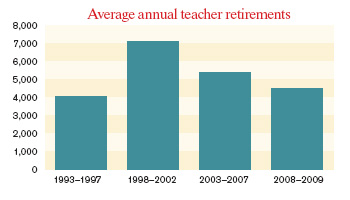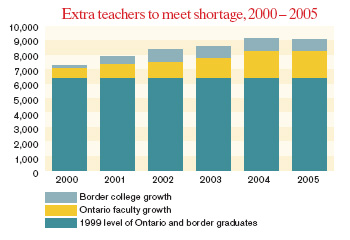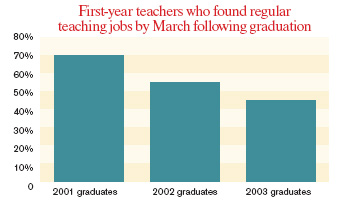![]()
Teacher Shortage Is Over
Ontario's widespread shortage of the past seven years has come to an end, though specific shortfalls persist.
by Frank McIntyre
How, When and Why of Teacher-Designed Sites
Part I: Exploring a World Wide Web of Possibilities
by Lynda Scarrow
research by Leata Lekushoff
Part II: How-To Guide
by Lynda Scarrow
Professional Learning Communities
Model for collaborative teaching or the latest bandwagon?
by Leanne Miller and Gabrielle Barkany
 |
The Teacher Shortage Is OverOntario's widespread teacher shortage of the past seven years has come to an end, though specific shortfalls persist.by Frank McIntyre |
Ontario's teacher shortage is over.
That knowledge, however, will be cold comfort to principals who cannot find qualified candidates for some specific teaching assignments where scarcities persist.
Those recruitment challenges - in French, mathematics, science and technology - could also soon be a thing of the past if the government and faculties of education react as effectively as they did in dealing with the general teacher shortage that the province faced eight years ago.
The annual supply of new teachers has grown substantially since 1999. This increase means that Ontario school boards were able to recruit the large number of replacement teachers they needed in a time of unusually high rates of teacher retirement across the province.
The increase in teacher supply occurred because government and faculties of education both in Ontario and New York State heeded the warnings of the College and other stakeholders.
The annual teacher retirement rate has fallen considerably and it continues to ebb further from the record-high numbers of just a few years ago. For the first time since the mid-1990s, Ontario is entering a time of reduced general demand for new teachers.
At the same time, however, a handful of persistent staffing problem areas remain for the province's school boards - specialized assignments and subjects for which many boards continue to have difficulty recruiting qualified replacement teachers. As the need for generalist teachers recedes, French (first and second) language, technology, physics, chemistry and math teachers, among others, remain in high demand even as the province's generalized teacher shortage fades into history.
Shortage was forecast
Professionally Speaking first published reports in 1997 that alerted the province to a looming crisis in the supply of qualified teachers. These predicted a sharp rise in demand for teachers from 1998 through 2005, mainly owing to a substantial spike in retirements as teachers hired in large numbers in the 1960s and early 1970s started to leave the profession.
In 1998, the first in a series of studies based on the College's then-new registry of Ontario-qualified teachers assisted education stakeholders in better understanding the emerging needs of school boards in the face of the predicted shortages. The surge in demand was to be widespread, with all areas of elementary and secondary teaching affected in every region of the province.
"The retirement exodus rose to 7,000 annually for the five years, 1998 to 2002."
College reports forecast retirements and related demand implications for generalist elementary and secondary teachers, for specific secondary teaching subjects and for specialized areas such as French-language teaching, technological studies, vice-principals and principals.
That same year, College Council formally urged the province to fund 10,000 extra spaces over five years in Ontario's faculties of education to meet the fast-rising demand for more teachers.
An analysis of 1999 data from both the College and the Ontario Teachers' Pension Plan further refined the regional and subject breakdowns and confirmed the unusually high retirement era as extending through 2005.
Ontario teacher retirements did, in fact, rise dramatically as predicted.
From an annual average of some 4,000 retirements in the five years 1993 to 1997, the retirement exodus rose to 7,000 annually for the five years 1998 to 2002. By 2003 the annual retirement rate had fallen to 5,500 and it is expected to return to the more normal rate of about 4,500 annually as we approach the end of this decade.
Increased supply
The Ontario government responded to the College's call for more teachers by adding more teacher education places at Ontario faculties. The base number of funded one-year teacher education spaces at the province's teacher education faculties rose from 5,000 for 1998-99 to 6,500 by 2000-01 - a level that continues through 2005-06.
Including graduates of 2005-06, the province has funded a total of 9,000 additional places in faculty of education programs than would have been funded if the government left funding at the 1998-99 level and enrolment had been flatlined.
In addition, several new teacher education programs have been established in recent years, such as those at the University of Ontario Institute of Technology and Trent University. These are further adding to the annual supply of teachers in the province.
"Only one in 13 Ontario teachers is now leaving the profession within their first three years."
During this time, with news of the availability of teaching jobs in Ontario, interest in the teaching profession rebounded. From historic low annual rates of fewer than 8,000 applicants in 1997 and 1998, the Ontario Universities' Application Centre reports that interest has surged to about 15,000 annually in the past few years.
Despite the substantial growth in provincial pre-service capacity, still more people sought to become teachers than could be trained in the expanded Ontario faculties of education. Many Ontarians turned to US border colleges for their teacher education. The number of new Ontario teachers graduating from US programs has grown substantially, from an average of about 500 per year in 1998 and 1999 to about 1,300 per year from 2002 to 2004.
 |
Brock graduates in transition to becoming teachers |
The increase in funding to Ontario education faculties, the introduction of new programs and the growth in US border-college graduates have combined to produce 12,000 more teachers - between 2000 and 2005 -- than would have existed if the annual supply had remained at the 1999 level. This growth fully met the temporary general teacher-shortage challenge originally identified by College Council in 1998.
This decade
In tandem with diminishing retirements, fewer teachers are leaving the profession in the early years of teaching. New Ontario teachers are now staying in the profession to a much greater extent than in many other jurisdictions - within their first three years only about one in 13 Ontario teachers is now leaving the profession.
"Targeted recruitment and induction support can help to relieve these remaining pressures."
As well, some teachers who retire do not leave immediately. Many teachers who opt for the early retirement opportunities that are now a permanent feature of the Ontario Teachers' Pension Plan continue to teach for a few more years under pension provisions that permit up to 95 school days of teaching per year, further adding to the supply of teachers available to school boards.
These recent shifts - increased supply, lower attrition rates of new teachers, more post-retirement teachers - have produced substantial growth in the profession. One indicator of this growth is the increase in Ontario College of Teachers membership from 172,000 in 1998 to 193,000 in 2004.
Signs of oversupply
The College's Transition to Teaching study of new teachers in their early years in the profession highlights that some new teachers are already experiencing greater difficulty in finding employment as the general teacher shortage recedes into history.
In the third year of this study we found that, although most 2003 teacher education graduates were employed in teaching by March of 2004, only 45 per cent of them had obtained regular teaching positions in that first school year. This compares with the 55 per cent among 2002 graduates and 70 per cent for 2001 graduates in their first years in teaching.
This reduced success in finding regular teaching jobs provides evidence that Ontario school boards are moving out of the recent high-demand period.
The jobs story for new Canadians certified as Ontario teachers in 2003 was significantly worse - in fact, the College's research shows it to be dismal indeed. The Transition to Teaching study found that by March 2004 fully 15 per cent had not found teaching jobs and, of those who were teaching, only 38 per cent had obtained regular teaching jobs.
Some shortages persist
Although the general teacher shortage is clearly over for Ontario, substantial staffing challenges in filling specialized teaching roles continue to plague Ontario school boards.
The 2004 phase of the College's Transition to Teaching study found that certain new graduates continue to be in high demand, especially graduates of French-language teacher education programs and those with physics, chemistry, mathematics, computer science, business studies and technological qualifications. Among the graduates of 2003, those who hold these qualifications had a 50 per cent greater chance of landing a regular teaching appointment in the first year following graduation.
Another indicator of specialized shortages can be found in the number of school board requests for hiring and assignment exemptions each year. In each of the past three years, school boards have required between 2,700 and 3,000 special authorizations for regulatory exemptions because they were unsuccessful in their attempts to recruit appropriately qualified teachers for advertised job vacancies - through both Letters of Permission and Temporary Letters of Approval (TLA).
Ministry of Education data on Letters of Permission issued to school boards to hire individuals who are not qualified as teachers in Ontario shows that school boards continue to be unsuccessful in recruiting certified teachers for more than 1,200 openings each year.
Among the areas for which school boards could not find certified teachers are French first language, French and English as second languages, technological studies, foreign languages, business studies, Special Education, sciences and mathematics.
The College of Teachers issues TLAs when school boards wish to assign a licensed teacher without the specific qualifications required for the assignment because they have tried but were unable to recruit teachers with the required additional qualifications for the assignments.
The 2003-04 school year saw a record number of these TLAs, with 1,500 authorizations across the province. French as a Second Language, Special Education, teacher librarian, technological studies and English as a Second Language each reached their highest annual numbers of TLAs province-wide since the inception of the College in the 2003-04 school year.
Addressing the future
With the threat of the general teacher shortage successfully met, attention and resources will still be needed to address the persisting shortages for qualified teachers in certain specialized roles - French first and second language, sciences, mathematics and technology. Targeted recruitment and induction support can help to relieve these remaining pressures facing Ontario's school boards.
More effort is needed to attract and support French-language teacher education candidates as well as individuals with science, mathematics and technical backgrounds.
Induction support is another key to successfully addressing these shortfalls. The College's Transition to Teaching study continues to find that many new teachers are handed assignments in shortage areas such as Special Education and French as a Second Language, teaching assignments for which they often have little or no preparation or support.
Enhanced induction programs can contribute to success in these early teaching roles and increase the likelihood that new teachers will continue in these high-need fields longer than if they are left on their own.
The 2004 Transition to Teaching study also found that many new Canadian teachers, including some with backgrounds in sciences and mathematics who met the qualifications for certification in Ontario, had not succeeded in finding regular teaching jobs. Better induction support for these teachers can also contribute to moving beyond the last remnants of Ontario's teacher-shortage crisis.




Leadership shortage continues
The retirement wave that washed through the profession over the past seven years has presented school boards with difficulties in the staffing of principal and vice-principal positions. In December 2000, the College forecast that more than 75 per cent of those qualified for principal and vice-principal positions would retire this decade and that almost half would do so by 2005. These retirements have greatly challenged school board recruiters.
English- and French-language school boards report many unsuccessful searches for principal and vice-principal vacancies every year. Since 2000, the College has issued an average of 175 Temporary Letters of Approval (TLAs) annually to allow boards to appoint teachers who do not hold the required qualifications for these leadership roles.
Despite the fact that, so far this decade, about 1,000 Ontario teachers per year completed their Principal's Qualification certification, the 2004-05 school year is on track to slightly exceed the average of 175 TLAs for the decade.
This leadership shortage is most severe in French-language school boards, with an average 20 per cent of these annual TLA requirements - a rate highly disproportionate for boards with a student population that is approximately five per cent of the provincial total.





